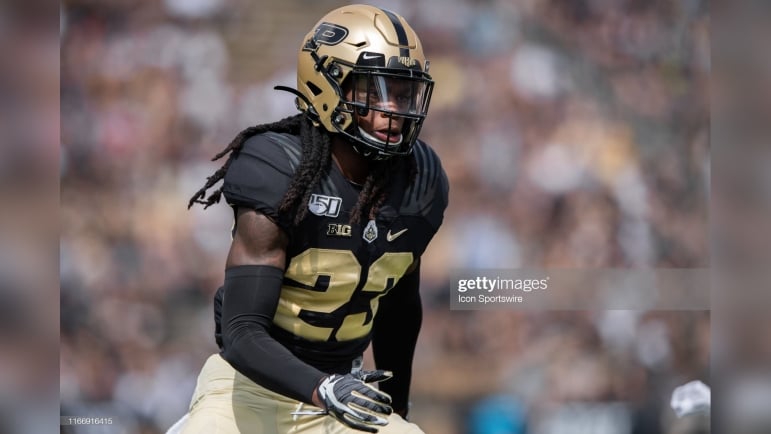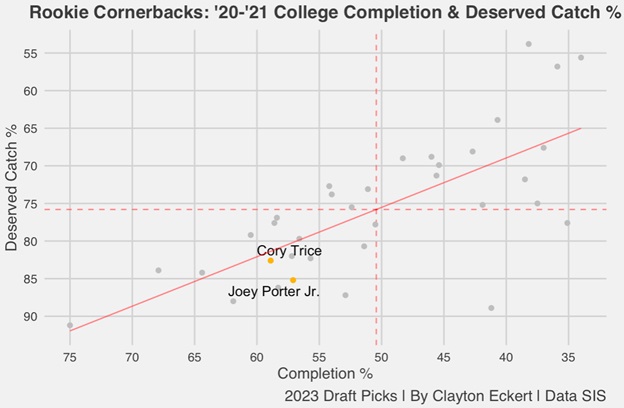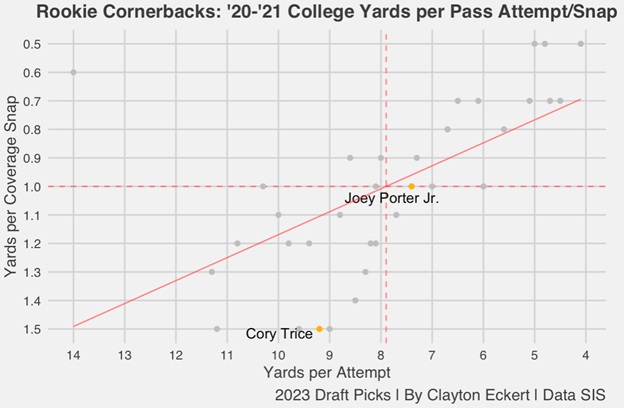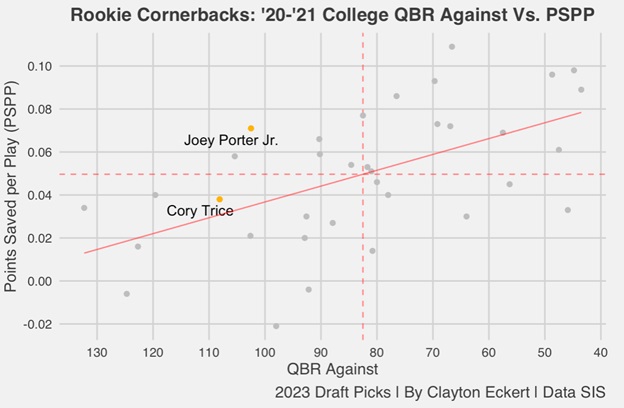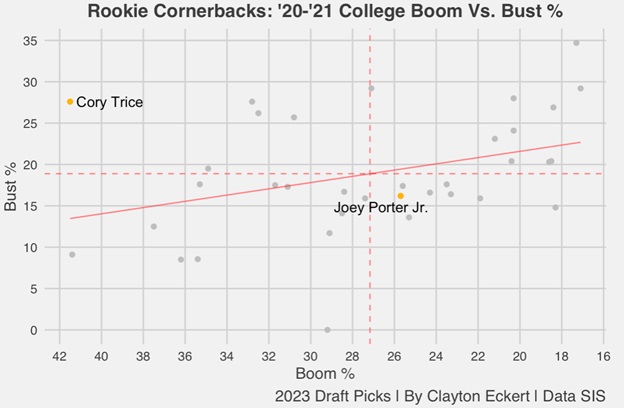Continuing the series, I wanted to examine the cornerback position further, with a similar approach to my 2022 article. Today’s goal is to look at and provide stat context for the position using Sports Info Solutions (SIS). The data in this study looks at their 2020 and 2021 seasons combined, focusing on the players who heard their names called in the draft, and one player was excluded due to SIS not tracking smaller schools. The goal is to see how Joey Porter Jr. and Cory Trice Jr. stacked up among their peers and how their college careers trended.
First, let’s look at opportunities with coverage snaps and targets:
From 2020-2021, Porter Jr. had 578 coverage snaps. That ranked 13th among the 35 qualifying cornerbacks, and tied for the ninth most targeted, landing above the mean in opportunities in the time frame. This is encouraging considering he ranked much lower in coverage snaps last season, highlighting above average experience, and was targeted at a much higher rate than 2022, which is important to factor as we dive deeper. In comparison, Trice landed on the bottom left with just 236 coverage snaps, which allows me to point out the injuries he dealt with in his college career, playing (and starting) only eight games in two years. Hopefully this is in the past, and he can continue encouraging availability as he did in 2022.
Now let’s begin to examine the quality of play now that we understand the quantity, with completion percentage and deserved catch percentage. That is the number of completions and drops divided by the number of catchable targets and passes defensed:
Both players land on the bottom left, very different than their 2022 results when they were encouragingly and comfortably above the mean. During this span though, Porter ranked 25th in completion rate and 30th in deserved catch percentage, prior to making a huge leap last season with an outstanding second rank and 16th, respectively. Trice also improved, ranking 30th in completion percentage and 27th in deserved catch rate from 2020-2021, followed by a 12th rank in each last year. Of course, you’d like to see more consistency year to year, but the quality season they are coming off is encouraging recency context.
I was also curious to see the type of coverage schemes the players were in, obviously another important piece of the puzzle, and here are those percentages from PFF:
| PLAYER | MAN% | ZONE% |
| Joey Porter Jr. | 24.4 | 61.9 |
| Cory Trice | 25.5 | 68.1 |
Here we see the rookie cornerbacks had very similar rates in man coverage from 2020-2021, very important context compared to their 2022 seasons, when Porter Jr. provided a whopping 45.1% and Trice just 17.8. Porter zone rates were much different as well, with 61.9% from compared to just 37.5% last year, while Trice was more similar (68.1, 71). They both played out wide primarily in each of the three years, and the biggest takeaway is if and when Trice gets outside corner snaps with the Black and Gold, he will likely need to play much more man, a projection that will be interesting to monitor if that is indeed the case.
Next, let’s look at the depth of targets with yards per attempt and yards per coverage snap:
Porter had respectable results, above average in yards per attempt (15th) and at the mean per snap (T-16th). Trice, on the other hand, was well below average in this regard from 2020-2021. That tied for last in yards per coverage snap along with a 26th rank per attempt. Both players improved last season, when Porter impressively tied for second in each, while Trice was 23rd in both, which was still below average. Extremely encouraging to see positive trajectory once again, particularly from Porter, who had more consistency.
Another stat that is used often to evaluate defenders in coverage is QB Rating Against. Let’s see how they fare along with Points Saved Per Play (PSPP), which is the total of a player’s EPA responsibility while in coverage using the Total Points system that distributes credit among all players on the field for a given play (with positive numbers being good). Totals are scaled up to map to the average points scored or allowed on a team level, with the player’s snap count determining how much to adjust. For pass defenders, this includes accounting for pass rush, broken tackles, dropped interceptions, turnovers, and turnover returns. Values are modulated using a quality-of-competition multiplier based on each opponent’s previous year of performance:
Looking at Porter first, we see a nice PSPP result from 2020-2021 that ranked 10th, including an interception and solid tackle rates in coverage, compared to a 2022 season that lacked in these terms. Both cornerbacks were well below average in QBR Against, ranking 28th and 31st during that span, and once again improved last year. Porter Jr. tied for 11th while Trice jumped to an average 18th rank in both data points.
To close, let’s look at boom and bust percentages from SIS to see how the cornerbacks performed on extreme end of the spectrum plays:
- Boom % = The percentage of dropbacks that resulted in an Expected Points Added (EPA) of 1 or more (a very successful play for the offense)
- Bust % = The percentage of dropbacks that resulted in an EPA of -1 or less (a very unsuccessful play for the offense)
Porter ranked 17th in boom percentage, an above average result that he also achieved in 2022, when he was 10th best (including no touchdowns allowed). That is another encouraging and more consistent aspect of the three college seasons, limiting big offensive plays, which is great to see. He was below the mean in bust rate though ranking 24th and took a step back in 2022, ranking dead last. This is an unfortunate flipside, and something he and the Steelers must correct sooner rather than later. Trice lands on the top left, with a strong bust percentage that impressively tied for fifth best. He had a particularly strong 2020 season as a tackler in coverage, an encouraging facet of his game that he was also able to provide last year. Unfortunately, we see he allowed big plays from opposing offenses at the highest rate of all 2023 draft picks in the span though, including three touchdowns allowed. Trice did improve in 2022, but was still below average in this facet, ranking 26th and another touchdown allowed.
In regards to the data and the outlook for 2023, we largely saw improvements from the rookie cornerbacks as their college careers progressed, namely in catch percentages, yardage allowed, and QBR Against. Porter had a high rate of coverage snaps and targets compared to his peers and his 2022 campaign, when he particularly regressed in bust rate and PSPP and was largely consistent limiting big offensive plays. Trice’s limited opportunities and injuries are surely notable as we consider his future, but improving nearly every aspect from a quality standpoint is very encouraging. One exception was bust rate, faring better from 2020-2021 with a top-five result. Overall, I’m very encouraged with their trajectory. I can’t wait to see if their improvements can carry over and if they can make strides and improve on some of their weaknesses. One thing’s for sure, I can’t wait to see how it all plays out for the rookies this year and beyond.
Throughout the rest of the offseason, I will dive deeper into the data as we continue to learn about the newest Pittsburgh Steelers. How do you think Joey Porter Jr. and Cory Trice will fare their rookie year? If you have any questions on the rest of the drafted cornerbacks across the league, please ask. Thanks for reading and let me know your thoughts in the comments.

